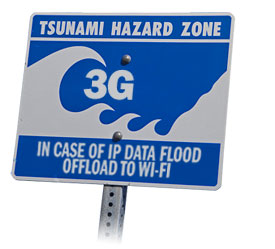
Five years ago, the dividing lines were clear. There was your Wi-Fi world, drafting off a home or office broadband connection; and your mobile world, for most other scenarios. But Wi-Fi is becoming a much larger part of the overall connectivity framework, driven by the spread of portable devices, the thirst for nearly persistent broadband connectivity, the relative high cost (to provide and consume) mobile data, and the limited capacity of cellular networks.
There has been accelerated activity in Wi-Fi, all heralding a much more dynamic relationship between cellular and W-Fi networks. The Wi-Fi roadmap promises some important enhancements, such as:
- 802.11ac, referred to as gigabit Ethernet, should provide an approximately 2x improvement in Wi-Fi speeds in real world situations. We will see the first devices equipped with 801.11ac over the coming months, likely including the next iPhone.
- Hotspot 2.0. The Wi-Fi Alliance has been hard at work. The mobile-centric highlights of Hotspot 2.0 include: mobile devices automatically joining Wi-Fi in a Hotspot 2.0 area; more dynamic Wi-Fi offloading for mobile operators; and management of cellular and Wi-Fi connectivity between applications.
- LTE Release 11 and Release 12. Both LTE Release 11 and Release 12 feature improved interworking with Wi-Fi, and more seamless handoff between cellular and Wi-Fi networks. Most cellular infrastructure going forward will incorporate some elements of Wi-Fi.
The importance of Wi-Fi in the broader mobile ecosystem has been validated by the purchases of Meraki and BelAir by Cisco and Ericsson, respectively, and the success of companies such as Ruckus Wireless, which makes Wi-Fi equipment focused on helping wireless operators leverage Wi-Fi.
On the business side, we are seeing significant expansion of publicly available outdoor Wi-Fi hotspots. The CableWi-Fi Alliance, formed barely a year ago, now operates nearly 150,000 hotspots nationwide, two-thirds of them from Comcast and Cablevision. Time Warner claims to have deployed 12,000 hotspots in the Los Angeles area alone. The cable companies typically offer free access to their existing broadband subscribers, with a marketing message centered around “content everywhere” and “an alternative to expensive cellular data plans”.
Municipal Wi-Fi is also experiencing somewhat of a resurgence. Gowex, an innovative Spanish company, offers free Wi-Fi in more than 70 cities, through an unusual public-private partnership model. In March, they launched a 2,000 hotspot network in Manhattan and last week opened a network in San Francisco. The City of San Jose announced the launch of a “Wickedly Fast Wi-Fi Network” throughout the downtown core, through a partnership with SmartWAVE Technologies and Ruckus Wireless.
Also exciting is the “neighborhood hotspot” concept–think “crowdsourced Wi-Fi.” A special router incorporating two signals–a “private” signal for the home and a “public” signal–allows some of the Wi-Fi bandwidth to be shared as a public hotspot. Spain-based FON pioneered the idea that subscribers who permit their residential hotspots to be shared can then access any of the other 8 million hotspots in the network. FON has partnerships with several telcos and wireless operators. At the Cable Show earlier this month, Comcast announced a similar concept, called “Neighborhood WiFi,” whereby residential home gateways broadcast a separate Wi-Fi signal, potentially adding millions of hotspots to the “Xfinity Wi-Fi” network for its customers.
What’s the Impact?
On a broader level, continued improvement in Wi-Fi capabilities (speed, range, etc.) and the expansion of indoor and outdoor hotspots mean greater intermingling of cellular and Wi-Fi networks. Broadband companies, such as cablecos, might take greater “connectivity” share.
For wireless operators, Wi-Fi is clearly “frenemy” territory. On the one hand, they rely on Wi-Fi for offloading and general capacity management. There is no way cellular networks, even with more spectrum, LTE-A, and the like, can singlehandedly handle the expanding thirst for rich media on mobile devices. On the other hand, if broadband customers become increasingly reliant on the availability of hotspots, they might opt for lower cellular data “bucket” plans, or opt not to buy cellular-enabled tablets or other connected devices.
The increasing wealth of connectivity solutions will lead to innovative business models. What is being advocated by FON, Comcast, and the like, fits comfortably with the “sharing economy” encapsulated by Zipcar, AirBnB, and bike share programs. With residential Wi-Fi gateways and smartphones as “hotspots,” one could envision some sort of connectivity “marketplace” akin to how utilities operate in the private sector.
I also envision data plans incorporating a combination of Wi-Fi and cellular service. One early example is Republic Wireless, an MVNO offering a $19 per month unlimited voice/text/data plan using a Wi-Fi first strategy, with the Sprint network acting as the backup in areas outside Wi-Fi coverage. Other wireless operators might start more actively managing indoor and outdoor wireless hotspots and offer plans, offering an “always best connected” capability optimizing service quality and and cost for the consumer, as well as their own “cost” to deliver data. A major Internet or media company such as Amazon or Netflix could launch an MVNO that makes very dynamic use of various connectivity scenarios.
Envision the landscape three years from now, in which we have this incredible mix of macro cellular networks, complemented by tens of millions of small cells and publicly available/shareable hotspots. There will be more opportunities to offer creative connectivity solutions, different than today’s bifurcated cellular/broadband model. I believe that over time, an increasing number of consumers will have one “connectivity” relationship, incorporating fixed and mobile broadband.
Finally, all these small cells and hotspots will be assets that can be used for applications beyond connectivity. Location services will become significantly more accurate, opening up opportunities for all sorts of targeted advertising and data analytics. A more dynamic relationship between the macro cellular network and the “smaller cell” network is also critical to the next phase of connected development, powering the “Internet of Things” that is important to the future of mobile.
* * *
Original article by Mark Lowensteinavailable here.
